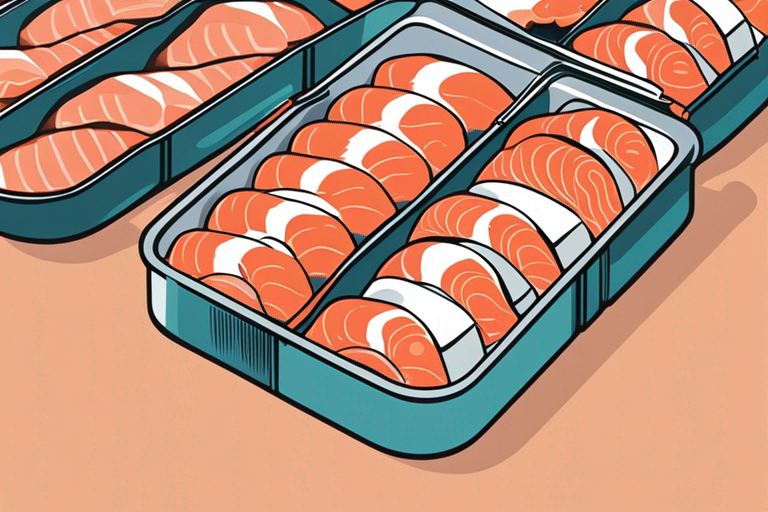
Is Your Canned Salmon Safe to Eat? Understanding Expiration Dates
Get Your Free Food Safety Cheat Sheet
30 most common foods with instant answers. Print it and stick it on your fridge—completely free!
Is Your Canned Salmon Safe to Eat? Understanding Expiration Dates
In the world of canned foods, expiration dates can be a bit confusing. Many people wonder if canned salmon is safe to eat past its expiration date. In this comprehensive guide, we will delve into the topic of canned salmon expiration dates to help you make informed decisions about the safety and quality of your canned seafood.
Understanding Expiration Dates on Canned Salmon
Canned salmon, like other canned foods, typically comes with an expiration date stamped on the can. It's essential to understand that expiration dates are not always set in stone and can vary depending on various factors. Here are some key points to consider:
Factors Affecting Canned Salmon Expiration Dates
-
Storage Conditions: Proper storage is crucial for maintaining the quality and safety of canned salmon. Storing cans in a cool, dry place away from direct sunlight can help extend their shelf life.
-
Quality of the Can: Damaged or dented cans can compromise the integrity of the product inside and may lead to spoilage. Always inspect the can for any signs of damage before consuming the contents.
-
Type of Salmon: Different types of salmon (e.g., pink, sockeye) may have varying shelf lives. It's essential to check the specific expiration date on the can for accurate information.
-
Processing Methods: The way canned salmon is processed and preserved can impact its shelf life. High-quality canning processes can help extend the product's freshness.
Decoding Expiration Dates
-
"Best By" Date: This date indicates the manufacturer's recommendation for consuming the product for the best quality. Consuming canned salmon after this date doesn't necessarily mean it's unsafe, but the quality may deteriorate.
-
"Use By" Date: This date signifies the last date recommended for the use of the product while at its peak quality. It's advisable to consume canned salmon before this date for optimal taste and texture.
Safety Tips for Canned Salmon Storage and Consumption
Ensuring the safety of your canned salmon involves proper storage and handling practices. Here are some essential tips to keep in mind:
Storage Tips
-
Store canned salmon in a cool, dry place away from heat sources and direct sunlight.
-
Avoid storing cans in areas prone to temperature fluctuations, such as near the stove or refrigerator.
-
Check the expiration date on the can before consuming the contents.
Handling Tips
-
When opening a can of salmon, inspect the contents for any signs of spoilage, such as off smells or unusual colors.
-
Use clean utensils to handle canned salmon and transfer any leftovers to a sealed container for refrigeration.
Signs of Spoiled Canned Salmon
While canned salmon is known for its long shelf life, it's essential to be aware of signs indicating spoilage. Here are some common indicators that your canned salmon may have gone bad:
Signs of Spoilage
-
Foul or off-putting odor emanating from the can when opened.
-
Unusual discoloration or mold growth on the salmon.
-
Noticeable changes in texture, such as mushiness or sliminess.
If you encounter any of these signs, it's best to discard the canned salmon to prevent potential foodborne illnesses.
Conclusion
In conclusion, understanding canned salmon expiration dates is crucial for ensuring food safety and quality. While expiration dates provide guidance on the freshness of the product, factors such as storage conditions and handling practices also play a significant role. By following proper storage guidelines, handling tips, and being vigilant for signs of spoilage, you can enjoy your canned salmon safely and deliciously. Remember, when in doubt, it's always better to err on the side of caution and discard any canned salmon that shows signs of spoilage. Enjoy your seafood responsibly!

Authoritative Food Safety References
These agencies and university labs inform every tip and health precaution we publish.
USDA FoodKeeper – Cold Storage Guidelines
Official refrigerator, freezer, and pantry timelines maintained by the U.S. Department of Agriculture.
Visit USDA FoodKeeperFDA Produce Safety Rule & Grower Guidance
Field-to-fridge handling practices that prevent contamination of fruits, vegetables, and leafy greens.
Visit FDA Produce SafetyCDC Foodborne Illness Prevention Hub
Surveillance-backed guidance on pathogens, symptoms, and steps to reduce foodborne illness risk.
Visit CDC Food SafetyUC Davis Postharvest Technology Center
University research detailing optimal storage atmospheres for produce after harvest.
Visit UC Davis PostharvestPenn State Extension – Home Food Preservation & Safety
Peer-reviewed extension bulletins on safe canning, chilling, and reheating practices.
Visit Penn State ExtensionWhat is the shelf life of canned salmon?
Can I eat canned salmon past its expiration date?
How can I tell if canned salmon has gone bad?
Can I store opened canned salmon in the refrigerator?
Is canned salmon safe for pregnant women and children?
Get Your Free Food Safety Cheat Sheet
30 most common foods with instant answers. Print it and stick it on your fridge—completely free! Want more? Upgrade to the complete guide with 70+ foods.
Scan your food directly and get instant safety info using our AI-powered camera feature.